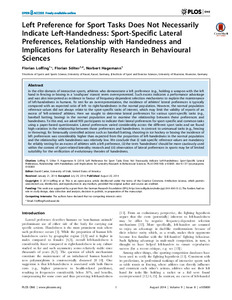Aufsatz
Artikel (Publikationen im Open Access gefördert durch die UB)

Left preference for sport tasks does not necessarily indicate left-handedness
(Sport-specific lateral preferences, relationship with handedness and implications for laterality research in behavioural sciences)
Abstract
In the elite domain of interactive sports, athletes who demonstrate a left preference (e.g., holding a weapon with the left hand in fencing or boxing in a ‘southpaw’ stance) seem overrepresented. Such excess indicates a performance advantage and was also interpreted as evidence in favour of frequency-dependent selection mechanisms to explain the maintenance of left-handedness in humans. To test for an overrepresentation, the incidence of athletes’ lateral preferences is typically compared with an expected ratio of left- to right-handedness in the normal population. However, the normal population reference values did not always relate to the sport-specific tasks of interest, which may limit the validity of reports of an excess of ‘left-oriented’ athletes. Here we sought to determine lateral preferences for various sport-specific tasks (e.g., baseball batting, boxing) in the normal population and to examine the relationship between these preferences and handedness. To this end, we asked 903 participants to indicate their lateral preferences for sport-specific and common tasks using a paper-based questionnaire. Lateral preferences varied considerably across the different sport tasks and we found high variation in the relationship between those preferences and handedness. In contrast to unimanual tasks (e.g., fencing or throwing), for bimanually controlled actions such as baseball batting, shooting in ice hockey or boxing the incidence of left preferences was considerably higher than expected from the proportion of left-handedness in the normal population and the relationship with handedness was relatively low. We conclude that (i) task-specific reference values are mandatory for reliably testing for an excess of athletes with a left preference, (ii) the term ‘handedness’ should be more cautiously used within the context of sport-related laterality research and (iii) observation of lateral preferences in sports may be of limited suitability for the verification of evolutionary theories of handedness.
Citation
In: PLoS one. - Lawrence, Kan. : PLoS, 2014, Vol. 9, Issue 8, e105800, 1-8Sponsorship
Gefördert durch den Publikationsfonds der Universität KasselCollections
Publikationen (Psychologie und Gesellschaft)Artikel (Publikationen im Open Access gefördert durch die UB)
Citation
@article{urn:nbn:de:hebis:34-2014103046210,
author={Loffing, Florian and Sölter, Florian and Hagemann, Norbert},
title={Left preference for sport tasks does not necessarily indicate left-handedness},
journal={PLoS one},
year={2014}
}
0500 Oax 0501 Text $btxt$2rdacontent 0502 Computermedien $bc$2rdacarrier 1100 2014$n2014 1500 1/eng 2050 ##0##urn:nbn:de:hebis:34-2014103046210 3000 Loffing, Florian 3010 Sölter, Florian 3010 Hagemann, Norbert 4000 Left preference for sport tasks does not necessarily indicate left-handedness :Sport-specific lateral preferences, relationship with handedness and implications for laterality research in behavioural sciences / Loffing, Florian 4030 4060 Online-Ressource 4085 ##0##=u http://nbn-resolving.de/urn:nbn:de:hebis:34-2014103046210=x R 4204 \$dAufsatz 4170 7136 ##0##urn:nbn:de:hebis:34-2014103046210
<resource xsi:schemaLocation="http://datacite.org/schema/kernel-2.2 http://schema.datacite.org/meta/kernel-2.2/metadata.xsd"> 2014-10-30T13:03:50Z 2014-10-30T13:03:50Z 2014 1932-6203 urn:nbn:de:hebis:34-2014103046210 http://hdl.handle.net/123456789/2014103046210 Gefördert durch den Publikationsfonds der Universität Kassel eng Urheberrechtlich geschützt https://rightsstatements.org/page/InC/1.0/ 796 Left preference for sport tasks does not necessarily indicate left-handedness Aufsatz In the elite domain of interactive sports, athletes who demonstrate a left preference (e.g., holding a weapon with the left hand in fencing or boxing in a ‘southpaw’ stance) seem overrepresented. Such excess indicates a performance advantage and was also interpreted as evidence in favour of frequency-dependent selection mechanisms to explain the maintenance of left-handedness in humans. To test for an overrepresentation, the incidence of athletes’ lateral preferences is typically compared with an expected ratio of left- to right-handedness in the normal population. However, the normal population reference values did not always relate to the sport-specific tasks of interest, which may limit the validity of reports of an excess of ‘left-oriented’ athletes. Here we sought to determine lateral preferences for various sport-specific tasks (e.g., baseball batting, boxing) in the normal population and to examine the relationship between these preferences and handedness. To this end, we asked 903 participants to indicate their lateral preferences for sport-specific and common tasks using a paper-based questionnaire. Lateral preferences varied considerably across the different sport tasks and we found high variation in the relationship between those preferences and handedness. In contrast to unimanual tasks (e.g., fencing or throwing), for bimanually controlled actions such as baseball batting, shooting in ice hockey or boxing the incidence of left preferences was considerably higher than expected from the proportion of left-handedness in the normal population and the relationship with handedness was relatively low. We conclude that (i) task-specific reference values are mandatory for reliably testing for an excess of athletes with a left preference, (ii) the term ‘handedness’ should be more cautiously used within the context of sport-related laterality research and (iii) observation of lateral preferences in sports may be of limited suitability for the verification of evolutionary theories of handedness. open access Sport-specific lateral preferences, relationship with handedness and implications for laterality research in behavioural sciences In: PLoS one. - Lawrence, Kan. : PLoS, 2014, Vol. 9, Issue 8, e105800, 1-8 Loffing, Florian Sölter, Florian Hagemann, Norbert doi:10.1371/journal.pone.0105800 8 PLoS one S. 1-8 9 </resource>
The following license files are associated with this item:
Urheberrechtlich geschützt

